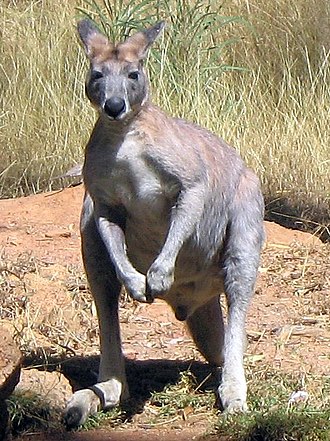The average global temperature is predicted to rise 2-3°C by the end of the century, placing approximately 20-30% of the world’s species at risk of extinction. The possible impacts on kangaroo populations are not well understood, but these could include changes in rainfall and fire frequency, food availability, fertility, species distribution, and heat-related die-offs.
The following information comes from the University of Chicago Press Journals. Global Warming Threatens Australia’s Iconic Kangaroos, ScienceDaily, 16 October 2008.
“Our study provides evidence that climate change has the capacity to cause large-scale range contractions, and the possible extinction of one macropodid (kangaroo) species in northern Australia,” write study authors Euan G. Ritchie and Elizabeth E. Bolitho of James Cook University in Australia.
Ritchie and Bolitho used computer modeling and three years of field observations to predict how temperature changes that are considered to be likely over the next half-century might affect four species of kangaroos. They found that a temperature increase as small as a half-degree Celsius may shrink kangaroos’ geographic ranges. An increase of two degrees may shrink kangaroos’ ranges by 48 percent. A six-degree increase might shrink ranges by 96 percent.
Ritchie says that generally accepted climate models predict temperatures in northern Australia to be between 0.4 and two degrees warmer by 2030, and between two and six degrees warmer by 2070.
“The most significant effects of climate change are not necessarily on the animals themselves, but on their habitats—specifically, in amounts of available water. This is particularly true in Northern Australia,” says Ritchie.
“If dry seasons are to become hotter and rainfall events more unpredictable, habitats may become depleted of available pasture for grazing and waterholes may dry up,” the authors write. “This may result in starvation and failed reproduction … or possible death due to dehydration for those species that are less mobile.”
And although kangaroo species may be mobile enough to relocate as the climate changes, the vegetation and topography for which they are adapted are unlikely to shift at the same pace.
The antilopine wallaroo, a kangaroo species adapted for a wet, tropical climate, faces the greatest potential risk. Ritchie and Bolitho found that a two-degree temperature increase may shrink its range by 89 percent. A six-degree increase may lead to the extinction of antilopine wallaroos if they are unable to adapt to the arid grassland that such a temperature change is likely to produce.
“Large macropodids are highly valuable economically, through both ecotourism and a commercial meat trade, and many species are an important food source for indigenous people,” they write. “Therefore, it is critically important that we understand the ecology of Australia’s native herbivores to ensure any further economic development will occur in an environmentally sustainable way.”
Personal Musings
The Australian Federal Government is doing little to reduce climate change and a lot to increase climate change. Australia ranks 61 out of 61 countries for its climate change policies, because our policies are theoretical words on paper rather than intended to achieve practical results. We can’t help wondering if the continuation of the commercial harvest of kangaroos, despite most populations being on the brink of extinction, is the Government’s way of making a buck off the kangaroo now before numbers die out due to climate change destroying habitat.

